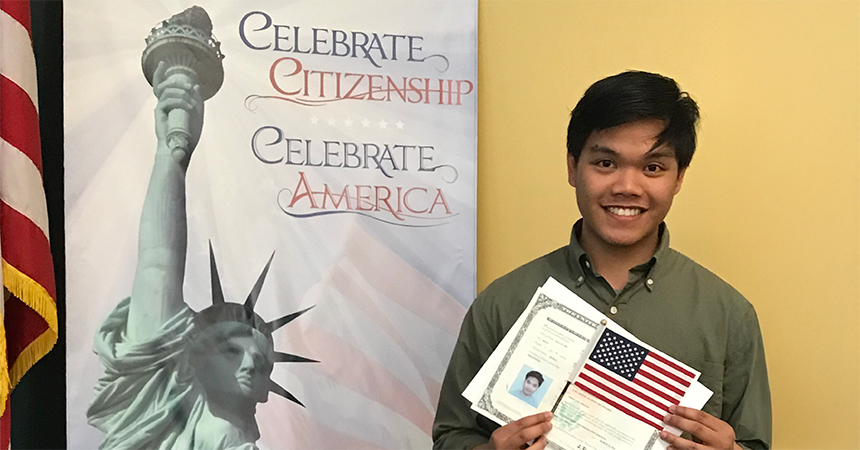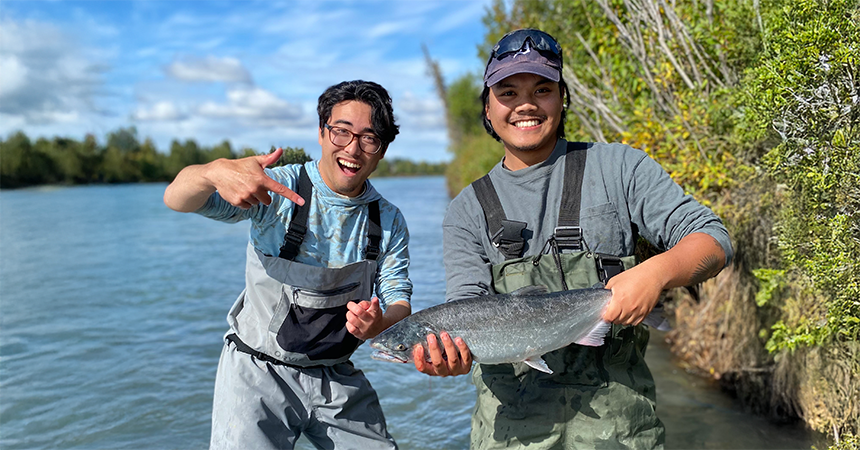
This is a part of a series of blog posts amplifying community voices. These views reflect the perspective of the Changemaker and do not necessarily represent those of Energy Trust.
EJ Del Rosario is a designer at West of West Architecture & Design, a small architecture practice based in Portland and Los Angeles. His path to the field was not traditional, sparked by a passion for art and design — including ceramics and collaging — and eventually majoring in environmental studies as an undergraduate. Since getting his master’s in architecture at University of Oregon, he has completed an internship at Opsis, made possible by Energy Trust of Oregon’s Net Zero Emerging Leaders Internship Grant, and is now an active member of the Portland chapter of National Association of Minority Architects (NOMA PDX).
What inspires you?
I was born in the Philippines and moved to Gresham, OR when I was five. I saw the hardships my parents went through to bring us to this country, and it instilled a drive in me to make whatever path I took worthwhile and exciting – to make their sacrifices worth it. I’m lucky my parents have always supported me in doing what I want. Art and design have been my passions since high school – things like jewelry, drawing and metalsmithing. I also feel like I grew up with the city of Portland, exploring the city and being inspired by the different subcultures and urban design.

EJ at his naturalization ceremony (age 19), when he became a U.S. citizen.
What led you to architecture?
After high school, I didn’t know what to do. I knew I had a natural interest in art and even got a scholarship to Pacific Northwest College of Art (PNCA), but it felt a bit risky considering I was a first-generation student. So went to Mount Hood Community College to figure out what I wanted to do. I took a sculpture course with a PNCA teacher who was such an inspiring person. He noticed I was good with my hands and told me I should do more things in 3D, like architecture.
So, I applied to University of Oregon’s architecture program but got rejected. I had no idea how competitive it was or that I needed a portfolio and references just to apply. But I was still determined, so I enrolled as an undeclared undergraduate, and took an intro to architecture course. I applied again to the architecture school for the winter term but was rejected again since it had only been 10 weeks and I still had no references or portfolio.
And you continued pursuing an education in architecture, despite being rejected twice from the master’s program?
I found out that you can minor in architecture, so I majored in environmental studies and sciences. It turned out to be great decision because it allowed me to hop in and out of different cohorts at school. I started talking to architecture students, picking their brains about the master’s program and looking at their portfolios, and just generally asking what it’s like learning architecture. It was inspiring hearing how others found their place in the field and the range of impact design can have.
Once I was accepted into the master’s program, I didn’t take anything for granted. I reached out to professionals as much as possible to get their perspective on the industry. Mentors have been the biggest thing for me. What I love about this community is so many people are willing to help. They understand that architecture academia is different from professional architecture.
As a college student, how did you approach architects and other professionals?
I would reach out via email and go to every networking event that I could. If I saw an event for anything architecture adjacent, I’d go and try to talk to anyone who was willing. I was often the only student there, and it became a natural process where I learned how to have good conversations and be approachable. I would work within anyone’s schedule and invite them to coffee, just so I could pick their brains. I never expected a job offer or the most insightful perspective. I just wanted to learn from them.

EJ at his first architecture studio, while still an undergraduate majoring in environmental science. It was an experimental studio providing a course for non-architecture major students.
In these informational interviews, did anything stand out or surprise you?
I was surprised to learn that everyone is so different — not a single person had the same upbringing or perspective. People from humble backgrounds who had worked their way up to being partners at firms, and who were willing to take the time and share their experience. That was inspiring to see. And it became clear that the design community and standards in Portland are at such a high level for the size of the city. There is such a strong and generous community here.
How did sustainable design become a focus for you?
It was my environmental studies degree that sparked that passion. Not just the mechanics of sustainability, but the aesthetic and form it can take for a holistic approach. Also, having grown up in southeast Portland, riding my bike all over, I had seen what small-scale urban design looked like and what worked well while thinking differently — simple interventions like closing one block to motorized traffic or embracing the benefits of density and diversity.
And you were also an Intern at Opsis through Energy Trust’s Net Zero Emerging Leaders Grant program in 2024. How did that come about and what did you learn during your internship?
I’d done a summer internship at Opsis in 2023, and as it was coming to an end, Heather DeGrella, their Sustainable Design Director, approached me about the Net Zero Emerging Leaders Grant program, which offers funding to firms to hire interns. It was an intimidating, technical position, but I learned so much, including an understanding of the entities of different energy modeling systems and how they get integrated into phases of construction. There were also valuable learnings about working with different teams, developing presentations, and summarizing information so it’s usable. There’s the technical side but also a lot of self-discovery through the intensity of the experience.

Fishing with a friend in Alaska
Have these skills transferred to your work at West of West?
We are a small studio and the partners definitely encourage sustainability and the proof points to back it up whenever possible. Right now they’re working on a tenant improvement for a former church that now houses a nonprofit, and they’re consulting with Energy Trust of Oregon to align with the right incentives that could also help guide the design direction. And we are always looking for opportunities to reuse materials that are onsite instead of tearing down an entire building. Sustainability is not just a mechanical thing; it can also take form and aesthetic into account. Our office really embraces opportunities where there could be a play with new and old, high-tech and low-tech, etcetera.
What’s it like being a member of NOMA PDX?
It’s hands down the best organization I have ever been a part of. Almost every office in Portland is represented — from emerging professionals to partners decades into the game. It’s truly a thriving organization of motivated architects and designers, making a difference. I have met so many inspiring, talented people and have found support through structured and informal mentorships, licensure, and student and professional development. They also provide so many great ways to give back to local communities. I have been involved with the community engagement committee that is advertising a free summer architecture camp for middle school students, and our board does a great job of finding tabling events, especially in underrepresented communities. I have been told so many times from interested parents that they are grateful for opportunities like this. I feel very lucky to have a way to give back, since I feel like I have been given so much. It’s extremely fulfilling.

EJ with his classmates in Ecuador, learning about bamboo architecture.
Do you have any advice for people who are searching for a career path, or trying to gain traction in their chosen field?
I would say approach life and your goals from a place of curiosity, lean in and be ready for challenges. Once I figured out that I wanted to do architecture, I put all my marbles in that basket.
I graduated during the pandemic, and jobs were hard to come by. I kept busy and learning by taking an autoCAD course. After that I went to Ecuador for a bamboo architecture workshop where I lived in a forest for two weeks learning the applications. I was the only environmental studies student — everyone else was in engineering and architecture programs. I was down to do anything, and it gave me huge satisfaction to create opportunities for myself.
